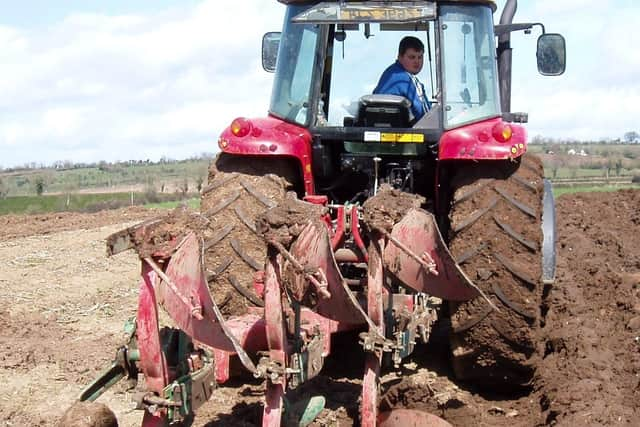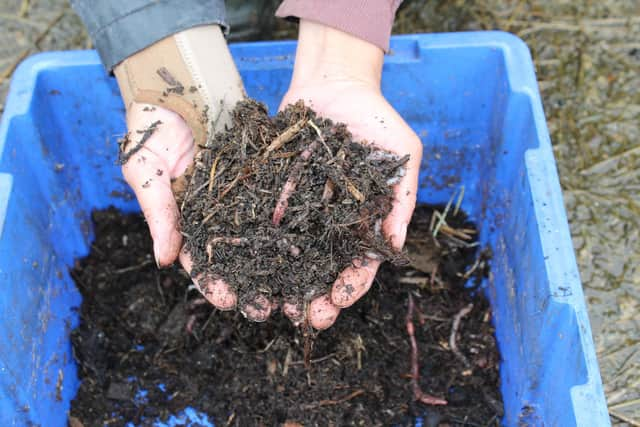Soil science to play a key role in farming agriculture’s response to climate change
and live on Freeview channel 276
This was the view very clearly expressed by Teagasc’s Dr David Wall, courtesy of his presentation to the soils conference, held recently in Belfast.
The event was jointly hosted by the British Soil Science Society (BSSS) and the Soil Science Society of Ireland (SSSI).
Advertisement
Advertisement
But according to Wall, there is no silver ‘bullet’ coming down the track in terms of soil research programmes delivering an over-arching response to climate change.


He also recognises that much of the public debate, where farming’s response to climate change is concerned, has centred on methane emission levels from ruminant livestock.
He added:
“It’s very easy for farmers to focus on their livestock.
"For one thing they are working with their animals on a daily basis.


"So the issue of developing the likes of a feed additive is a very tangible subject for them to comprehend,” said Dr Wall.
Advertisement
Advertisement
“Making technologies of this kind work would physically require farmers to include whatever product we might be talking about into a ration on a regular basis.
“Soils, on the other hand, are much more abstract in nature,” Dr Wall continued.
"And, as a result, they tend not to get prominence in terms of farmers’ perception levels on a regular basis.”
Soil management
Wall used his conference presentation to specifically highlight a number of soil-related management choices that will act to mitigate climate change.
Advertisement
Advertisement
Two of these include the tweaking of soil phosphorous levels and pH values.
He explained:
“We know that nitrous oxide emission levels are linked to available soil phosphate values.
"And the same principle holds where soil pH values are concerned.”
The soil scientist said that farmers should aim to have all fields in Index 3 for phosphorus.
Advertisement
Advertisement
Dr Wall also cited the role of available phosphate as a key constituent of the energy-related pathways that operate within all living organisms.
Teagasc recommends an optimal pH value of 6.3 for grassland, rising to 6.5 for cereal ground.
Research has confirmed that achieving these soil nutrient targets can result in nitrous oxide emissions reducing by up to 20% relative to current figures.
Much of this is already turning out to be a good news story for Irish agriculture.
Advertisement
Advertisement
David Wall referenced the significant upturn in lime usage throughout Ireland over the past few years.
Approximately 1.2Mt of agricultural lime was applied in Ireland last year. The comparable figure from a decade ago was 750Kt.
Courtesy of his presentation, David Wall confirmed that the European Union is actively working on the development of a soil framework directive, the recommendations within which will have a major impact on Irish agriculture.
One of the reasons why a measure of this nature has not been introduced to this point, according to the Teagasc representative, reflects the very complex nature of soils and the problems of coming up with accurate definitions.
Advertisement
Advertisement
But David Wall did confirm that soil management will be at the heart of farming’s response to climate change.
This will particularly be the case where issues such as air and water quality are concerned.
Climate change
Soils will also change with the continuing impact of climate change.
This means their ability to withstand and mitigate the extremes of drought and floods – that are already apparent – will be impacted accordingly.
Advertisement
Advertisement
“There are already a wide range of soils to be found across the island of Ireland and beyond,” David Wall explained.
“Different soil types will require differing management priorities into the future.”
He added:“Soil health is of fundamental interest to soil scientists.
"It is the facet of soils that determines their capacity to mitigate the impact of climate change.
Advertisement
Advertisement
“If we fail to protect soil health, this will limit the potential of our land to deliver eco services on behalf of everyone.”
The soil scientist went on to make the point that soils must also be managed in ways that deliver a financially sustainable future for farmers.
Soil Health
David Wall firmly believes that future soil health assessment policies must be established as part of a top-down process.
As part of this process he wants farmers and the wider agricultural industry to begin to assess the health status of their soils and to inform themselves of what technologies they could implement in order to maintain and enhance soil health in the future.
Advertisement
Advertisement
But, at the end of the day, the focus of future soil management policy to be endorsed by the EU will come down to agreements being reached on a range of very specific definitions.
For example, soil health is presently defined as the current capacity of soil to function as a vital living system, within natural or managed ecosystem boundaries, to sustain plant and animal productivity and health, maintain or enhance air or water quality and to provide further ecosystem services (on the long-term) without (increased) trade-offs between ecosystem services.
Soil fertility, on the other hand, is defined as the ability of a soil to sustain plant growth by providing essential plant nutrients, water and favourable chemical, physical and biological properties as a habitat for plant growth.
Two questions then arise from this. Will the forthcoming EU soil framework directive align itself with definitions of this nature?
Advertisement
Advertisement
And, if so, what will be the implications for Irish farmers?
David Wall again:
"All of these soil-related properties must be quantified onto three specific categories, moving forward: a reference value, a target value and a threshold value.
“It is also important that policy makers use the same language and in the right way when deciding on these matters.
“And then at a national level, there is the issue of how all of this will work out for Irish farmers.”
Soil health policies
Advertisement
Advertisement
According to David Wall, EU policy makers are currently assessing 40 different soil indicators.
He continued:
“The physical properties of soils must be considered in this context.
"But even here there is a range of complications to be addressed.
For example, do we restrict our assessments to top soil layers only?
"Or do we also include sub-soils?
Advertisement
Advertisement
“Structure is one of the fundamental issues that determine the overall function of our soils.”
Other soil indicators that determine the functioning of a soil include its chemical and biochemical properties plus the interactions of the soil microbiome and the other organisms that live within this unique habitat.
The conference was told that soils’ ability to sequester carbon will be an important issue within future climate change debates.
Specifically, where future drainage schemes are concerned, David Wall said this matter could well become a trade-off between land’s ability to produce food and the future environmental pressures that may be placed upon it.
Advertisement
Advertisement
Teagasc’s current research programmes recognise that healthy soils are at the heart of meeting challenges around food security, climate adaptation and environmental sustainability.
There is a fundamental principle involved: on the back of healthy soils, Irish agriculture can become more resilient to climate change, reduce input requirements, and reduce its environmental impact.
In turn, this will help to ensure the long-term viability of Ireland’s food production systems.
Carbon sequestration
Meanwhile, it seems that farmers face a ‘geographic lottery’ if plans to reward them financially for increasing soil carbon stocks are to be introduced.
This is according to Rothamsted scientists:
Advertisement
Advertisement
Rothamsted’s Professor Andrew Neal and Professor David Powlson.
They are are confirming that geological history alone determines the type of soil found on a farm.
And this is the key factor that may make capturing more carbon in the soil nigh on impossible for some farmers.
Professor Neal explained:
“Farmers on sandy soils will struggle to increase the carbon content of their soil.
Advertisement
Advertisement
"They might be doing all the right things to increase the carbon flowing through their soils, but it won’t show up when they come to test the soil.”
Common ways to improve soil carbon include the addition of manures or crop residues, growing cover crops in the winter and the rearing of grazing livestock and crops together.
The problem, says Professor Neal, is that the potential for carbon sequestration is strongly influenced by soil type — particularly texture —and the starting carbon content, which will be a legacy of past farming practices.
He continued:
“Changes in soil carbon in response to alterations in management practice occur slowly.
Advertisement
Advertisement
“It’s also difficult to measure the likely small changes in soil carbon within a short time period.
“Indicators such as soil microbial biomass are useful in showing whether organic carbon is increasing or decreasing in response to a change of management.
“But these measurements provide neither an estimate of soil carbon stocks, nor a prediction of absolute changes in carbon.”
Professors Neal and Powlson are proposing an alternative system that measures the flow of carbon through soil, rather than the actual amount in soil at a given time.
Advertisement
Advertisement
They refer to it as a dynamic rather than static view of soil.
“If a system of policy requirements or financial incentives for increasing soil carbon is to be instituted, we propose an alternative approach to be taken,” said Powlson.
“This will include the use of carbon models to predict probable changes in soil carbon taking account of the farmer’s soil type, local climate, cropping practices and starting soil carbon content,” Powlson continued.
“This could be combined with closer monitoring at a network of benchmark sites.”
He added:
Advertisement
Advertisement
“There is much interest in sequestering carbon in soil as a means of mitigating climate change by making payments to farmers in return for the amount of carbon sequestered.
“There are several ‘early warning’ methods that may be successful in detecting whether or not a soil is increasing its carbon content, and this is helpful,”continued Professor Powlson.
"But they will probably not provide direct evidence of the absolute change in total carbon that has occurred.”
Soil organic matter contains about 50% carbon and influences virtually all soil properties.
Advertisement
Advertisement
Recent research using Rothamsted soils by Professor Neal and colleagues has shown how the structure of the soil is affected by the processing of organic matter inputs by soil microbes as metabolites form associations with mineral particles.
The resulting structure in turn impacts oxygen diffusion through the soil and the microbial processing of carbon and other nutrients important for crop and livestock nutrition.
Professor Neal commented:
“Imaging of pore networks clearly shows how a clay-rich soil adapts to differences in organic inputs, but a sandy soil shows little adaptation.
“Thus, the physical structure and resulting changes in biological activity, are less influenced by organic inputs in sandy soils.”
He concluded:
“This is consistent with the observation that sandy soils have much less capacity to sequester carbon than soils of finer texture.”